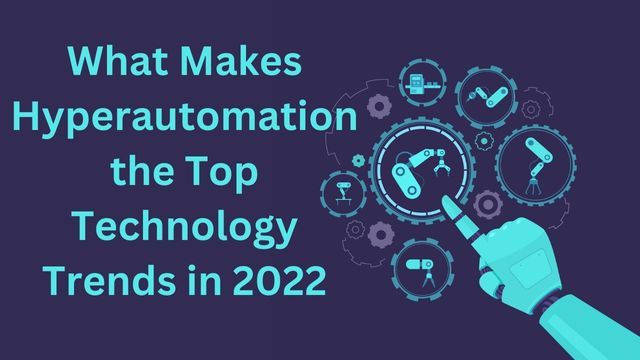What Makes Hyperautomation the Top Technology Trends in 2022

In 2022, automation is no longer a fantasy and is gaining ground quickly in a variety of sectors, from manufacturing to healthcare. Thanks to the epidemic that has sped up the rate of digital transformation across businesses, technologies like RPA and AI are making intelligent automation a reality, where bots can now complete jobs without the need for complicated coding.
Automation has replaced boring, repetitive work, improved the lives of employees, and dramatically increased production. Today, automation is pervasive everywhere. However, there will be more!
A new era of automation has arrived as a result of technological advancement; it focuses on developing superhuman powers rather than just duplicating and enhancing human abilities.
Over the next five to ten years, there will be considerable disruption and opportunity brought in, according to a top industry analysis firm, and hyper-automation will be at the forefront of that shift.
Interestingly, a renowned industry research and consultancy agency has listed hyper-automation as one of the top 10 important technological trends for 2022. As the name implies, hyper automation advances conventional automation.
What is hyperautomation?
According to one industry definition, it is a mix of tools to enhance AI-driven decision-making, including robotic process automation (RPA), intelligent business management software (iBPMS), and AI.
Simply said, hyper-automation integrates various tools and technologies, combines various automation components, optimizes processes, and amplifies automation to a completely new level.
It’s more than just automation!
Initially, automation required complex programming to execute work, but the introduction of RPA technologies made it much simpler, allowing bots to take over boring, repetitive jobs and communicate with other applications to carry out work more quickly and continuously.
The main drawback of RPA is that it can only automate straightforward jobs; those that could be programmed to adhere to predetermined rules had structured data and repeatedly followed the same procedure. Then it was over!
On the other hand, hyper-automation boosts the development of RPA and the variety of advantages it provides, including the ease of automation, efficiency, accuracy, speed, and other parameters, by extending the automation capability using a combination of disruptive technologies like artificial intelligence (AI) and machine learning.
Driving the automation-first era
Now more than ever, we are witnessing the emergence of an era where automation comes first. All those inhibitions, fears, uncertainties, and myths around automation have long since passed away.
With the development of an integrated workforce made up of humans and robots that may usher in new waves of growth, it is now simpler to envision a future where human involvement, innovation, and efficiency come first.
Hyperautomation will only advance automation as its application area widens, enabling businesses and consumers to fully grasp its enormous potential.
Who is it for, then? Everyone, we would say:
By utilizing automation, businesses have a tremendous opportunity to expand and transform. Employees would no longer be weighed down by menial, low-level tasks, which would allow them to stay motivated, think creatively, and offer answers.
Customers will receive more value when dealing with a company that prioritizes automation in all aspects of corporate operations.
By merging hyperautomation technology with newly developed operational processes, firms will reduce operational expenses by 30% by 2024, predicts a top industry analyst.
It’s not just a fad that won’t stick around, but rather a trend that will endure and usher in an intriguing future powered by intelligent automation.
Discover the potential of hyperautomation
Work may be completed quickly, effectively, and easily using automation. But hyperautomation opens up so many possibilities that it challenges our preconceived notions about what software bots are capable of.
- The future of work
- Advanced analytics
- Empowered and integrated workforce
- Manage automation at a large scale
- Increased productivity
Let’s examine some of the amazing advantages that hyper automation can offer and how it will become more and more important in a dynamic and ever-changing company environment.
The future of work
Hyperautomation can take automation to the next level. Automation focuses on reducing the load of time-consuming and repetitive jobs that don’t positively contribute to the growth of employees.
Industry researchers believe that by 2025, at least 1-2 million jobs will be related to AI, in contrast to the frequently heard statements that robots will make people out of work.
Advanced analytics
In a business setting, analytics by itself can produce amazing outcomes by sifting through raw data to reveal important insights and information that can be utilized to guide the development of the company. However, its capabilities are greatly increased by hyperautomation.
To tap into powerful data from various sources, act intelligently on it, and drive smart decisions, hyperautomation uses the synergy of a combination of AI technologies, improved business processes, RPA, and analytics.
This helps enterprises get a better understanding of current performance metrics, perform predictive analysis, and increase the power of data.
Empowered and integrated workforce
When robots and humans collaborate on a variety of tasks, from simple processes to sophisticated end-to-end procedures that require both human decision-making and automation, the result will be a workforce that is significantly more intelligent and superior.
A unified, integrated workforce that promotes business growth can result from this.
Manage automation at a large scale
Hyperautomation can open up a universe of interoperable tools operating in harmony to deliver maximum ROI and commercial advantage by removing the constraints that a single tool or technology is bound by.
This implies that by utilizing a variety of cutting-edge technologies, you may unleash the full potential of automation, identify all business activities that can be automated, and then fully implement it.
Hyperautomation can assist you in harnessing the entire power of automation, from the smallest activities to complex decision-making and predictive analyses.
Increased productivity
Hyperautomation involves incorporating humans into the processes so that they may collaborate with technology rather than just duplicating jobs and automating them through robotic process automation (RPA).
Everyone can be given the ability to automate and participate in the change, from developers to business analysts. Employees may train automation tools to support their evolution, engage AI for better decision-making, and access cutting-edge insights to reinvent their work and increase productivity with such collaborative intelligence at work.
Hyper Automation Trends to Know for 2022
- “Low-code” will trickle down into Hyperautomation Skills
- Hyperautomation will create a new era of “digital twins.”
- Automation Looks Beyond Routine Tasks
- Hyperautomation Goes Mainstream
- Commoditization of RPA
- Automation is Reimagining Teams
- No Signs of Slowing Down
Tools for hyperautomation have already been implemented by many businesses, which is transforming how work is done.
Experts predict that every firm will actively use at least three of the 20 central processes that underlie hyperautomation within the next two years. The top hyperautomation trends to watch in 2022 are listed below:
“Low-code” will trickle down into Hyperautomation Skills
Business technologists are in charge of the hyperautomation projects among non-IT staff. Business technologists now make up 41% of the workforce, a rise in this percentage demonstrating the high demand for hyperautomation skills in modern enterprises.
To succeed, this group of technology leaders will require the right equipment and instruction. Vendors of hyperautomation will offer no-code AI products that give non-technical business users more access to machine learning models.
Teams of business technologists will receive more uniform training from organizations. Low-code tools will transition from a useful competitive advantage to a standard in the industry. These simple, code-free solutions are predicted to manage close to 70% of development work by 2024.
For instance, low-code process automation systems can link everything together if a company has some of the fundamental building blocks for hyperautomation in place. They do this by unlocking and capturing structured data.
Workflows for data collection can be streamlined using these low-code platforms. For instance, operations that rely on paper can be quickly converted into digital ones, frequently under the direction of citizen developers who lack professional IT knowledge.
Hyperautomation will create a new era of “digital twins”
A digital twin replicates offline business processes online. To accurately reflect real-world situations, digital twins need an abundance of data, and hyperautomation is the ideal data glutton to support this trend. According to reports, 65 percent of decision-makers in the manufacturing sector anticipate using hyperautomation to create digital twins of their operations in the upcoming years.
Automation Looks Beyond Routine Tasks
Automation has been viewed as a blessing for increasing the effectiveness of tedious, everyday commercial processes. Business executives are nevertheless looking at innovative ways that hyperautomation might collaborate with human thought leaders in non-routine jobs.
Business companies are encouraging their workers to start considering the big questions they might pursue with the aid of AI, rather than lamenting the loss of basic, repetitive duties to a bot.
New opportunities are opened up for sales, client success, hospitality, and other positions that benefit from face-to-face communication by having a well-organized back office that can invoice, analyze, and report on data independently.
Human employees should not be considered extinct as a result of AI activity; rather, it should be seen as a tool to enhance their skill set with intelligence and insight that cannot be obtained manually. This ought to be a warning to companies that are putting off the implementation of hyperautomation.
Hyperautomation Goes Mainstream
As with most new technologies, hyperautomation has only recently gained traction among a small group of early adopters, primarily large businesses willing to invest a significant amount of money in experiments.
However, as technology advanced, prices decreased and became more affordable for SMEs with tighter budgets. Hyperautomation service providers are transforming their services into more accessible mini tools to better suit the changing needs of small- to medium-sized organizations.
Robotic process automation (RPA) technologies and other hyperautomation tools are increasingly available in consumer operating systems and smartphones.
Text can be inferred from a photo in iOS 15. Power Automate Desktop is a free feature of Windows 10 that gives regular PC users the ability to create effective IFTTT automation. RPA has spread so widely in some industries that vendors are now using it as a free hook to attract customers and hook them into additional premium services.
Commoditization of RPA
Vendors are refocusing their efforts on expanding their top-tier solutions as RPA becomes a more “entry-level” innovation. To provide consumers with a one-stop-shop for things like analytics, process mining, machine learning models, and more, they are vying to offer a thorough hyperautomation catalog.
The quantity and caliber of hyperautomation tools will increase as a result of the consolidation of services. This will lead to low-code trends that will make integrating incredibly creative hyper-automation services simpler than before.
Automation is Reimagining Teams
Automation has made many firms flexible, even throughout the pandemic. As many businesses resume their regular operations, they grow uncomfortable with the growing number of bots taking on tasks that were formerly the responsibility of human employees. By 2025, one in three jobs is anticipated to be replaced by automation. However, on the other side, it is predicted that artificial intelligence (AI) will create more employment than it will eliminate.
By the same year, according to Gartner, AI is expected to generate two million net new jobs. Both entry-level and highly competent, vision-driven top management will be home to these new positions as they emerge. To better equip their workers for the escalating technological trends, smart firms are revising roles and responsibilities. The software package for hyperautomation is not a danger.
Businesses must begin training “fusion teams.” Fusion teams are interdisciplinary and hybrid groups that include domain knowledge in both business and technology, such as analytics or technology, and share accountability for the results.
They are an additional tool that businesses can use to ensure the success of project implementation. Employees from many departments make up fusion teams, just like agile teams do. This promotes quicker digital delivery and gives the team greater autonomy and flexibility.
No Signs of Slowing Down
In 2022, hyperautomation will significantly alter corporate practices, and this trend shows no indications of abating. Adopting some of these building blocks can aid in making quick business choices that are supported by the best available data since 80 percent of CEOs expect to increase spending on digital projects this year and 72 percent anticipate shortening implementation delays.
Organizations are forced to examine their operations closely to identify the innovative potential for automation as a result of hyperautomation. By 2031, according to market analysts, this trend would soar to a startling $46.4 billion.
This expanding trend can aid in streamlining company procedures for data collection and analysis so that better judgments can be made. Organizations can rely on seasoned business process outsourcing businesses to guarantee the accuracy of business processes and data.
Hyperautomation in real life: How does it work?
Let’s think about a straightforward use of hyperautomation in the insurance sector: Financial institutions handle hundreds of claims settlement applications, and there are intricate procedures, analyses, approvals, and decision-making to be done between the time a loss is reported and the final claims payout.
Utilizing AI-powered systems that can interpret data from documents, chat, or other channels claims intake can be hyperautomated. The remaining steps in the process chain would then be automated by a robotic workforce, which would file a claim, evaluate, confirm, and compare estimates before reaching a conclusion that could subsequently be supported by human intervention.
Here’s another use case
Look more closely at your financial procedures. How long does it take an employee to submit their claim for reimbursement of expenses?
Furthermore, does it overburden your finance team with work? Your finance teams won’t have to manually sort through and process large amounts of bills thanks to hyperautomation, which uses OCR, AI, and RPA to automatically file reimbursement claims after reading data from a picture of a bill.
What more can hyperautomation do besides redesign processes? Think about digital marketing Intelligent technologies can be used to gather information from various social media sources, do sentiment analysis, and turn unstructured data into data that can be utilized to power new marketing campaigns or improve customer support.
And even that is only beginning to scrape the surface of the opportunities that hyperautomation can offer.
Hyperautomation anywhere
Hyperautomation can be used in a variety of industries, including manufacturing, healthcare, information technology, and insurance, and it can address a wide range of business difficulties. Boost your technical proficiency.
Include more tools. Include robots in your workforce. Investigate all possible automation options. Salute the upcoming tsunami of technological progress and change. Don’t you think it’s about time you experienced the actual power of automation?
Why is Hyperautomation needed?
Businesses have incorporated hyperautomation into their daily operations to improve staff skills, boost output by getting rid of tedious jobs, and lower operational expenses and errors. Each of these technologies is interdependent on the others and plays a crucial role in hyperautomation.
What is the future of hyperautomation?
According to a recent prediction from Gartner, the global market for technologies that enable hyperautomation would reach $596.6 billion in 2022. This is an increase from the automation technology market’s $481.6 billion in 2020 and $532.4 billion in 2021.
What is a hyperautomation example?
OCR-based document comprehension (Optical Character Recognition) utilizing NLP to interpret emails (Natural Language Processing) Automate replenishment and stock forecasting. Using AI/ML (Artificial Intelligence/Machine Learning), to improve automation processes.
- The Connection Between 5G and Happiness
- How To Stay Current With Technology Trends
- The Future of NavIC Satellite Navigation System in 2023
Conclusion
The lives of workers have improved as tedious, repetitive work has been replaced by automation. Hyperautomation is the combination of robotic process automation (RPA), intelligent business management software (iBPMS), and AI to improve AI-driven decision-making. One of the top 10 technology trends for 2022 is hyperautomation, according to a reputable industry study company.
According to a market expert, businesses will lower operational costs by 30% by 2024 by combining hyperautomation with newly created operational processes. Contrary to the widely held belief that robots would put people out of work, by 2025 at least 1-2 million occupations will be tied to AI.
Hyperautomation includes integrating people into the workflow so they can work alongside technology.








🙏 🙏 ❤ ❤ Always be updated with computer tips, mobile tips, how to fix, tech reviews, and tech news on Rowdytech, or subscribe to the YouTube channel.